I don’t present quite as many Every Child Ready to Read early literacy programs for parents and caregivers as I used to, and I miss them because they can be a lot of fun! A friend who is putting a parent program together asked for some advice recently, and these are the tips that came to mind.
Tell as many stories as you can.
One of the goals of the programs I presented was to help parents understand the six early literacy skills. Well, we are all–children and adults–wired for stories, and we make sense of the world through stories. I found that telling a little anecdote about my girls, or about something that happened in storytime, was a great way to catch attention and introduce a new idea. Then I could go on and share more of the nitty-gritty of how that skill helped build reading readiness.
When I talked about letter knowledge, for example, I would start by talking about how one day my almost-2-year-old daughter and I were walking in a pedestrian mall, and she suddenly stopped and squealed, “EEEEEEEEEEEEEEE!” and pretty much made me jump out of my skin. Well, when I looked, she was standing on a manhole cover, pointing down at her feet. It turns out she had seen the “E” in “SEWER” and was SO THRILLED to recognize it as the first letter of her name! It was just a little story, but it would get us started. I gathered as many anecdotes as I could for each skill or practice–borrowed them from other parents and librarians, noticed them in storytime–and stored them up along with my research and facts.
Let them tell stories.
Telling stories was also great because it made it easier for the parents and caregivers in the audience to tell their stories, too. Even in larger groups, you can ask for folks to talk about their own kids and their own experiences with language learning. If you’re talking about singing, ask them what their kids like to sing or listen to. Or if you’re talking about vocabulary, ask for their kid’s first word or most unusual word.
Having them share stories does a couple of things. It keeps you from being the only voice; we all naturally pay attention to new things, so a different voice speaking can help keep everyone more alert. I also found that there were lots of times I could piggyback on what they shared, adding another little bit of research or giving another example of an activity they could do with their kids. (“It’s so cool you guys like to say rhyming words at the grocery store, because one thing research tells us about rhymes is…”) It’s easier sometimes to listen to lots of information if it’s broken up into smaller chunks, rather than all rattled off together in one long spiel.
Have props.
Chances are, you’re going to be presenting in a boring meeting room. Bring some fun objects to help you make your points. I brought in the stop sign from my girls’ dress-up bin for when I was talking about environmental print, and I brought in the sports pages for talking about reading aloud to newborns, and I brought in a weirdly shaped rattle for talking about adverbs and describing words. Visuals are a plus!
Stay positive and practical.
In these types of programs, I believe that we want to emphasize what parents can do from here forward, not make them feel guilty about what they haven’t done until now. In other words, if you’re talking to parents of 4-5 year olds, don’t spend a lot of time talking about how 0-3 is the critical window for this or for that skill. Yes, we want them to know that the preschool years are full of incredible potential, but we don’t want them to go home and lose sleep because they didn’t read books to their child until they were 1. Or 3. Or even 4 or 5. We can all start now, and we can all make a difference.
I am a big fan of sharing the research and letting parents know all the cool things we now know about how kids get ready to read, but I think our most important goal for these workshops is to give them ideas for simple activities and games and strategies that they can go home and do that night at tuck-in time. Or the very next morning in the car on the way to preschool. Fun ideas that make them say, “Hey, I do that already!” or, “That’s easy, I can do that!”
Don’t hand out too much paper.*
We have lots of good ideas and lots of good research to share, but it’s still better to let them go with less than more in terms of handouts. The five practices are great as a handout, simple and practical; but we don’t want to overwhelm them with pages and pages of cute ideas from Pinterest or links to studies they probably won’t have time to read. Instead, emphasize that they can always ask you questions at the library later; give them your business card and tell them it’s your job and pleasure to talk with them!
*Except for booklists.
Recommended lists always seem to be a hit. Families new to reading aloud need a place to start and families who are old pros at the library love discovering new authors. Even when I would emphasize in my publicity that my programs weren’t about books, my feedback & evaluation sheets always said, “We want more recommended books!” This was my one big exception to not giving them too much paper–booklists always got picked up. And fresh new books on display tables gave everyone something to do while they were waiting for the program to start!
The other thing about having good books on hand is, if you don’t have a lot of stories and anecdotes gathered yet, you can use books as models for the skills and practices, and let the books tell your stories. One of my favorite things to do when we were talking about vocabulary was to read them a page of The Napping House, one of the later pages when everyone is really piled up on the bed, and just let all those great snoozy sleepy vocabulary words sink in. It was a simple, effective way of reminding people what awesome words are found in picture books, instead of just telling them so.
It’s way better to be too short than too long.
Cut your material till you can comfortably fit it in your time; don’t push it. There is so much great stuff to share, but only so much fits into the brain at one time, especially if you’re a sleep-deprived parent of young children! Plus, you need to respect their time. If they’ve arranged for childcare to be at your program, they are going to need to go when you said they were going to be able to go. If you finish your material before your time, you can let them go early, ask for more questions, or share great new picture books to fill in your time.
And, last but not least…
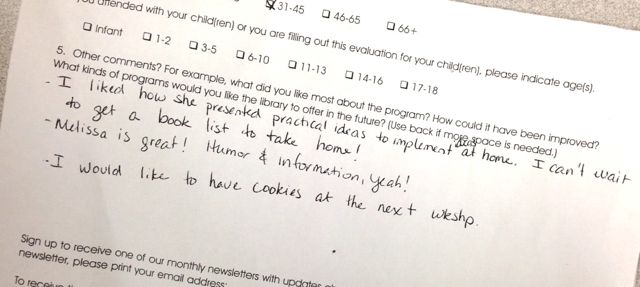
Pretty much my favorite eval ever.
Serve cookies.
Because, cookies. But seriously! Any parent or caregiver who sets aside time, arranges for childcare, and comes to a program deserves a treat. And you do, too.
Have fun with your parent programs! What are your top tips?


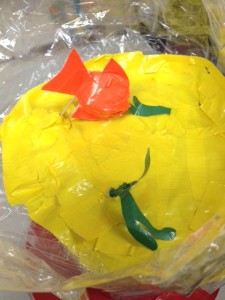


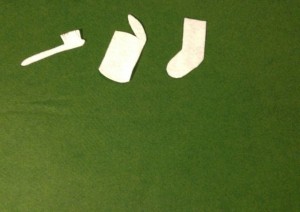
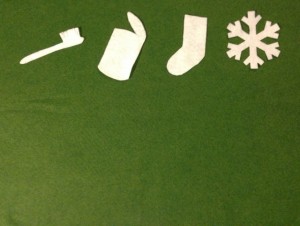



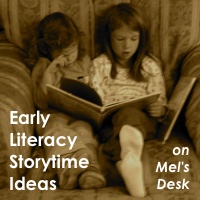


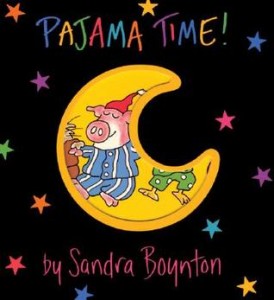
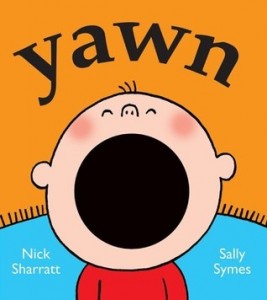


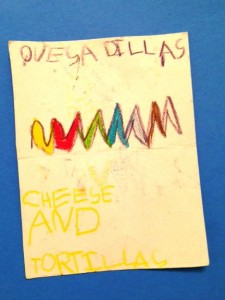
.jpg)
